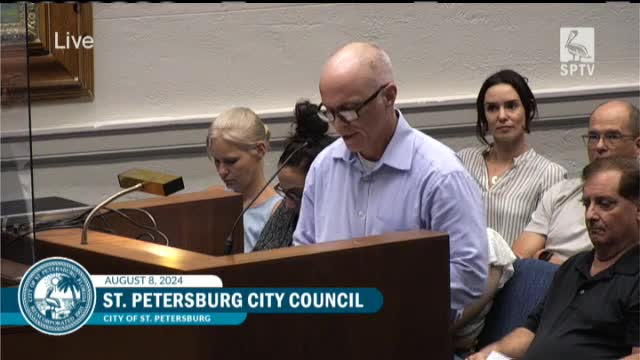Church rezoning sparks fierce community backlash
August 08, 2024 | St. Petersburg, Pinellas County, Florida
This article was created by AI summarizing key points discussed. AI makes mistakes, so for full details and context, please refer to the video of the full meeting. Please report any errors so we can fix them. Report an error »

In a recent city council meeting, the proposed rezoning of two parcels of land owned by Pasadena Community Church sparked significant debate among community members and officials. The church, which has served the area for nearly a century, is seeking to sell the property to fund necessary renovations and maintain its community services, which include a food pantry, preschool programs, and various outreach initiatives.
The church's representative emphasized the need for change, citing the aging infrastructure and the growing demands of their community services. They argued that a smaller campus footprint would enable the church to enhance its impact within the community, aligning with a vision articulated by a former pastor about the necessity of progress and adaptation.
However, opposition from local residents was strong. Multiple speakers raised concerns about the potential impact of the rezoning on the character of the historic neighborhood, which is known for its brick streets and large, historic homes. Critics highlighted that the proposed development could significantly increase traffic and density, potentially doubling the number of residents in an area that currently consists of approximately 280 homes. They argued that such changes would disrupt the established community fabric and set a concerning precedent for future developments in the area.
Residents also pointed to the city's comprehensive plan, which emphasizes the importance of maintaining the character of established neighborhoods. Many expressed fears that the proposed changes would not only alter the neighborhood's aesthetic but also negatively affect property values and the overall quality of life.
The council is now faced with the challenge of balancing the church's needs for financial sustainability and community service against the residents' desire to preserve the unique character of their neighborhood. As discussions continue, the outcome of this rezoning request remains uncertain, reflecting broader tensions between development and preservation in rapidly changing urban environments.
The church's representative emphasized the need for change, citing the aging infrastructure and the growing demands of their community services. They argued that a smaller campus footprint would enable the church to enhance its impact within the community, aligning with a vision articulated by a former pastor about the necessity of progress and adaptation.
However, opposition from local residents was strong. Multiple speakers raised concerns about the potential impact of the rezoning on the character of the historic neighborhood, which is known for its brick streets and large, historic homes. Critics highlighted that the proposed development could significantly increase traffic and density, potentially doubling the number of residents in an area that currently consists of approximately 280 homes. They argued that such changes would disrupt the established community fabric and set a concerning precedent for future developments in the area.
Residents also pointed to the city's comprehensive plan, which emphasizes the importance of maintaining the character of established neighborhoods. Many expressed fears that the proposed changes would not only alter the neighborhood's aesthetic but also negatively affect property values and the overall quality of life.
The council is now faced with the challenge of balancing the church's needs for financial sustainability and community service against the residents' desire to preserve the unique character of their neighborhood. As discussions continue, the outcome of this rezoning request remains uncertain, reflecting broader tensions between development and preservation in rapidly changing urban environments.
View full meeting
This article is based on a recent meeting—watch the full video and explore the complete transcript for deeper insights into the discussion.
View full meeting